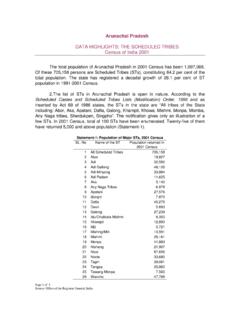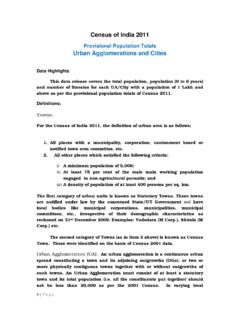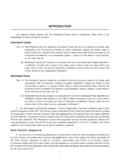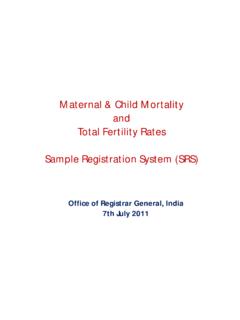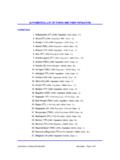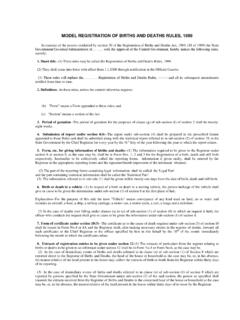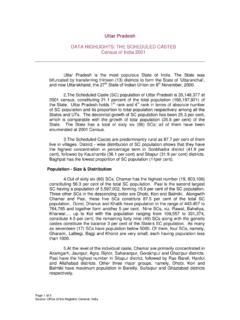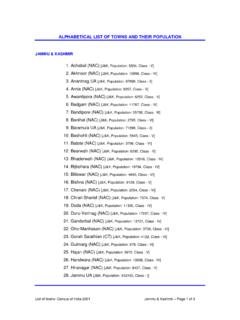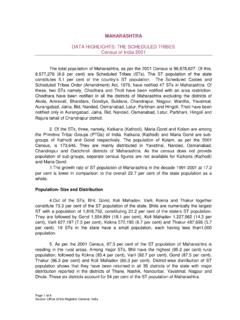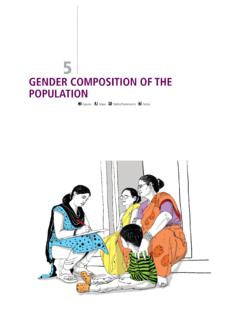Transcription of Orissa DATA HIGHLIGHTS : THE SCHEDULED CASTES Census …
1 Page 1 of 5 Source: Office of the Registrar General, India Orissa data HIGHLIGHTS : THE SCHEDULED CASTES Census of India 2001 The SCHEDULED Caste (SC) population of the State of Orissa , as per 2001 Census is 6,082,063. This constitute percent of the total population of the State. The State holds 11th rank and 12th rank among all the States and UTs in terms of the SC population and the proportion of SC population to the total population of the State respectively. The decennial growth of SC population has been per cent, which is per cent higher than the overall growth of the total population ( per cent). The State has a total of ninety-three (93) SCHEDULED CASTES , but ninety one (91) have returned their population at 2001 Census .
2 2. The SCHEDULED CASTES are predominantly rural with per cent residing in villages. Among the districts, the SCs have the highest concentration in Sonapur district with a share of per cent to the total population, followed by Jajapur (23 per cent) and Baudh ( per cent) districts. Gajapati district has the lowest proportion of the SC population ( per cent). Population - Size & Distribution 3. Out of ninety-three (93) SCs, Pan is the most populous caste having a number of 1,078,523 constituting per cent of the total SC population. Dewar is the second largest SC having a number of 648,937. Five other SCs in the descending order are Dom, Dhoba, Ganda, Kandra and Bauri.
3 Along with Pan and Dewar, the seven SCs constitute per cent of the total SC population. Ghasi, Namasudra, Chamar, Gokha and Haddi have a population ranging from 105,722 to 209,701. Together, they form 13 per cent. Six SCs, namely Tiar, Patial, Tanla etc. having population ranging from 49,675 to 98,885 constitute another per cent of the total SC population. Remaining seventy three (73) SCs along with generic CASTES constitute the residual per cent of total SC population of the State. As many as thirty two (32) SCs have population below 1000. Of them, eight CASTES namely Pamidi, Musahar, Godagali etc.
4 Are very small having population less than100. 4. District wise distribution of the individual SC population shows that Pan have the maximum population in Jajapur district followed by Kendujhar and Dhenkanal but they constitute the highest proportion ( per cent) of the total SC population in Kandhamal district. Dewar have the highest population in Cuttack followed by Ganjam and Khorda districts. Other five major groups Dom, Dhoba, Ganda, Kandra and Bauri are primarily concentrated in Kalahandi, Ganjam, Balangir, Kendrapara and Ganjam districts respectively. Sex Ratio 5. The over all sex ratio of the SC population in Orissa is 979 females per 1000 males which is higher than the national average of 936 for the total SC population.
5 6. At individual level, seven major CASTES have registered the over all sex ratio higher than the national average with Dom having a preponderance of females, their sex ratio being1007(Statement-1). Page 2 of 5 Source: Office of the Registrar General, India 7. The sex ratio among SCs, in the age group 0-6 years (958) is higher than that of the SCs at the national level. Among the larger groups, Dom have the highest (972) and Dewar the lowest (943) child sex ratio. All of the major CASTES have returned child sex ratio higher than that of the national average. Statement - 1 : Sex Ratio Age group All SCs (India) ) All SCs (State) Dom Dhoba Bauri Ganda Pan Dewar Kandra All ages 936 979 1007 983 981 979 974 964 959 0 6 yrs.
6 938 958 972 951 945 964 965 943 952 Literacy & Educational Level 8. The overall literacy rate of the SCs is per cent at 2001 Census , showing an improvement from that ( per cent) recorded at 1991 Census . This figure is marginally higher than the national average of per cent aggregated for all SCs. Male literacy has increased from per cent to per cent while female literacy has gone up from per cent to per cent during 1991-2001. Among the numerically larger CASTES , Dewar and Dhoba have more than 50 per cent female literacy followed by Kandra ( per cent). Dom have shown the lowest female literacy ( per cent).
7 Statement - 2 : Literacy Rate Literacy Rate All SCs Dewar Dhoba Kandra Ganda Pan Bauri Dom Persons 65 Females 9. Among SC literates, per cent are either without any educational level or have attained education below primary level. The proportion of literates who have attained education up to primary and middle levels constitute per cent and per cent respectively. Literates who are educated up to matric / higher secondary constituter per cent only. This implies that every 8th SC literate is matriculate. Graduates & above are per cent while non-technical & technical diploma holders constitute less than half per cent ( per cent) only.
8 Page 3 of 5 Source: Office of the Registrar General, India Statement - 3 : Levels of Education among the major SCHEDULED CASTES Educational levels attained Names of SCs Literate without educational level Below primary Primary Middle Matric/Secondary Higher Secondary/ Intermediate etc. Technical &Non-technical diploma etc. Graduate and above All SCs Pan 14 Dewar Dom Dhoba Ganda 13 Kandra Bauri 10. Among numerically larger groups, Dhoba have the highest proportion of matriculates, followed by Dewar and Kandra etc.
9 Bauri have the lowest proportion of matriculates. 11. The data on the education levels attained by all SCs shows that the drop-out rate is high after middle level as the percentage of middle level literate is almost half of the primary level literates and declines sharply from the higher secondary level onwards. Similar trend has been shown by the major SCs in the attainment of levels of education. 12. Out of the total lakh SC children in the age group 5 -14 years, only lakh children attend school, constituting per cent. As many as lakh children in the corresponding age group do not go to school. Among the major SCs, Dhoba have the highest proportion of school going children ( per cent); this proportion is above 60 per cent among Dewar, Ganda, Kandra and Pan.
10 Statement - 4 : Percentage of school going children in the age group 5-14 yrs. Age Group All SCs Pan Dewar Dom Dhoba Ganda Kandra Bauri 5-14 yrs. Work Participation Rate (WPR) 13. The Work Participation Rate (WPR) of the SC population is per cent which is marginally lower than that of total SCs at the national level ( per cent). This figure is same as that recorded at the1991 Census . While there has been an increase in female WPR from per cent to per cent, male WPR ( per cent) has declined by per cent during1991-2001. Among the total workers, per cent are main workers which is below the national average recorded for all SCs (73 per cent).
